How to create �Tube-fittings by G. Maroske
This document was last changed 10th Feb. 2001 - All copyrights by G.
Maroske
-
Inform yourself about the materials you are working with and read carefully
the safety instructions provided by the manufacturer!
Working with these materials is HAZARDOUS!!!
What is this document about?
This document covers the creation of very small Tube-fittings for
hard-shell kayaks.
It is decicated to the experienced fiberglass kayakbuilder and NOT
for beginners.
Beginners should take classes in fiberglass work.
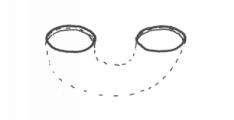
Why fiddeling with these Tube-fittings, if there are easier
ones?
The Tube-fittings were developed to transfer the maximum
of the applied forces into a large deck area with minimum impact to the
deck while installing.
If the kayak has a strong edge where the upper part of the gunwale
meets the deck (think of greenlandstyle plywood kayaks) the fitting can
be placed right at the edge so the fiberglass will transfer a part of the
applied forces into the hull. This brings maximum failure safety.
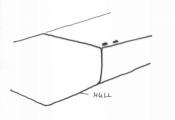
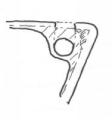
The piece where the rope runs around has a large amount of glass in
it which provides maximum support in comparison to a rod fitting. Instead
of high stressed points the load is distributed on a large area (hatched
area in the figure).
Tube fitting

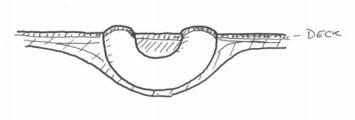

Rod� fitting
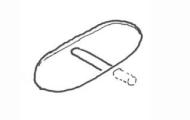
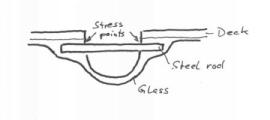
How to install Tube-fittings?
Read the instructions at least twice BEFORE you start drilling holes!
If you have never worked with fiberglass before get someone who
instructs you.
Resins, hardeners, dusts and fibers are no child toys and safety
precautions should be taken at each step.
Read the warnings above! If you do not know
what you are doing stop here and do not proceed!
The fittings are most easily installed before the deck is joined with
the hull.
But they also have been installed in complete kayaks.
Warning!! If working inside a kayak, provide
ventilatition of fresh air inside the kayak, wear breathing protection
and NEVER work alone! Irritant fumes and loss of breathable air may occur!
Buy non-reinforced soft-PVC-tube with an outer diameter of ~10mm (~3/8
- 4/8 inch) and a stiff rope with a diameter that fits tight into the tube.
Cut a 12cm (~5inch) off the tube . Pull 16-20cm (7-8inch) of the rope through
the tube. Use a needle to pinch a piece of twine through one end of the
rope. The rope is needed to prevent collapsing of the tube while bended
sharply.
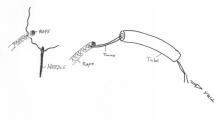
Take adhesive tape and cover the deck area where the fittings shall
be placed. Mark two holes in a distance of ~22mm (~7/8inch). Drill two
holes with the diameter of the tube. Sand the area inside thoroughly where
the fitting will be installed (wear at least a dust-mask or similiar, those
dusts are harmful!).

Make sure that you get a a snug fit of the tube in the holes to prevent
spilling resin later. From the inside of the hull stick both ends of the
tube to the outside. Leave a generous loop inside the hull.
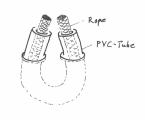
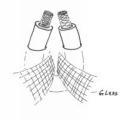
Push lots of fiberglass mats through it (do not take a stiff mat, use
fine roving mats of 200g or less per square meter). There should be a reasonable
buildup of glass. Cut some pieces 10x10cm (4x4inches) for covering (wear
at least a dust-mask or similiar, those fibers are harmful!).
Turn the boat upsidedown.

Wet the mats in the loop with resin and pull both ends of the tube tight
from the outside (wear at least skin and breath protection).
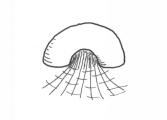
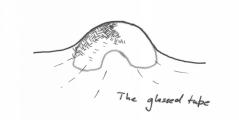
Cover the hump of the bended tube with glass and resin to end up with
a watertight covering.
To remove the tube pull out the rope first. Use pliers and pull strongly
on both ends of the tube. When the tube is stretched, it's diameter decreases
and it starts to loosen. This will reduce the adhesive forces. Cut off
one end of the tube as deep in the fitting as you can with a surgery knife.
Pull out the rest of the tube using the pliers.
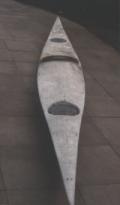
My boat with installed fittings.
Literature
-
Boatbuilder's Manual
edited by Charles Walbridge
Menasha Ridge Press
ISBN: 0-89732-022-0
costs about CAN$14,-
This book shows how to build boats and no river pigs. Originally designed
for whitwater paddlers all other builders will be provided with a bunch
of useful information about fiberglassing. Never found something comparable
to this fine manual.
!!!WARNINGS!!!
-
No guarantee is taken for completeness or errors in this document!
-
This document cannot and does not provide the information neccesary
to work with fiberglass and resins.
-
If you follow these instructions, you will do it at YOUR OWN RISK! I
will not replace your damaged boat or your health!
-
Working with resin, hardener, fiberglass and their dusts is at least
harmful, so wear eye, skin and breathing protection!
-
Work only in well ventilated areas!
-
Do not dump resin, hardener or other chemicals in your sewage system!
-
Keep resin, fiberglass and hardener out of reach from children!
-
Do not swallow resin or hardener!
-
Be careful with resins, which can take fire when heating up during cure!
-
Never heat up hardener prior to mixing because of low temperatures!
The result can be explosive!
-
Inform yourself about the materials you are working with and read carefully
the safety instructions provided by the manufacturer!
Working with these materials is HAZARDOUS!!!
 go to G Moroske's homepage
go to G Moroske's homepage
